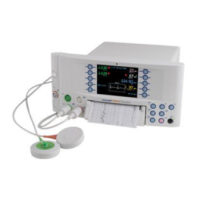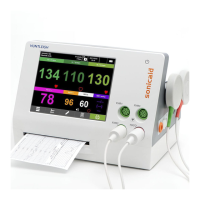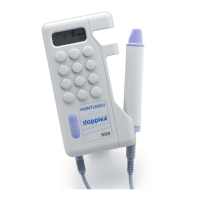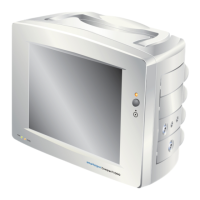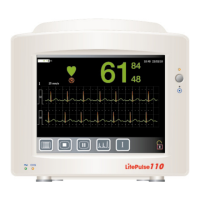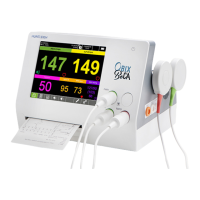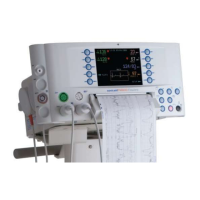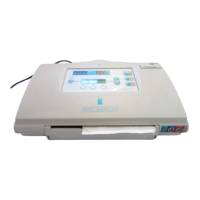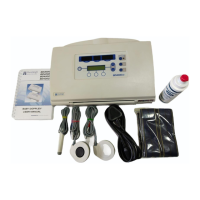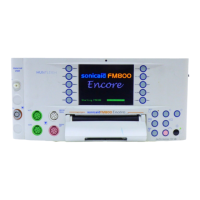
Do you have a question about the Huntleigh Sonicaid FM800 Encore Series and is the answer not in the manual?
| Model | FM800 Encore Series |
|---|---|
| Manufacturer | Huntleigh Healthcare |
| Display Type | LCD |
| Power Supply | 100-240V AC, 50/60 Hz |
| Connectivity | Wired |
| Fetal Heart Rate (FHR) Range | 50 to 210 bpm |
| Toco Range | 0 to 100 |
| Maternal Heart Rate (MHR) Range | 30 - 240 bpm |
| Printing Speed | 1, 2, or 3 cm/min |
| Interfaces | RS232 |
| Power Source | Mains and Battery |
| Compatibility | Compatible with accessories |
Identifies the specific issue status products to which this manual applies.
Lists the standards and directives the Sonicaid FM800 Encore complies with.
Describes the intended medical use of the Sonicaid FM820 and FM830 Encore fetal monitors.
Details restrictions and warnings for using the FM800E series monitors.
Covers requirements for connecting the FM800E fetal monitor to other equipment.
States there are no special calibration procedures for FM800E.
Provides guidance on using multiple portable socket outlets, including isolation transformers.
Ensures correct environmental conditions for FM800E to avoid interference.
Outlines standard terms, conditions, and procedures for returning the FM800E unit.
Lists the registered trademarks associated with the product and its components.
Provides information on approved oximeter sensors and care/disposal for probes.
Highlights residual risks that require warnings to be noted in the manual.
Explains the meaning of various symbols used throughout the manual and on the product.
Introduces the FM800E series monitors and their intended use in antepartum and intrapartum monitoring.
Identifies and describes the components and controls located on the front panel of the main unit.
Details the different connection sockets for various transducers and their corresponding types.
Identifies and describes the input/output connectors located on the rear panel of the main unit.
Describes the features and benefits of the FM800E's high-performance colour display.
Lists all transducers and cables supplied with the units and as optional accessories.
Provides instructions for safe handling, mounting, and positioning of the FM800E unit.
Explains the function of the front panel controls and the power on/off indicator.
Describes the layout and parameters displayed on the FM800E main monitoring screen.
Details the functionality of the software control buttons and their interaction with connected transducers.
Explains how to control audio volume and select the audio channel for monitoring.
Describes the front panel controls for the printer, including on/off, fast forward, and EasiNotes.
Explains the differences between Setup, Current Alarms, Default Alarms, and System Settings procedures.
Allows alteration of alarms for a monitoring session before transducer connection; changes are temporary.
Enables modification of the FM800E's default alarm settings, which remain permanent.
Covers user preferences that are protected by an access code and remain after power cycling.
Explains how to select Sonicaid CARE (antepartum) or Sonicaid TREND (intrapartum) analysis.
Provides instructions for resetting the date and time, and changing the date format.
Details how to enter and remove patient name, ID, and gestation period for trace headers.
Explains how to set a timer for alerts and how to acknowledge or turn it off.
Covers how to turn the actogram feature on/off and adjust its sensitivity and display settings.
Explains how System Settings and Default Alarms screens allow protected preference adjustments.
Details how to modify hospital defaults for alarms and how to reset to factory defaults.
Guides users through setting the hospital name, print header, and paper-out buffer options.
Explains how to control baby graphic display, audible key presses, event marks, and ECG waveforms.
Covers altering supply frequency, changing display language, and date format.
Details setting the appropriate serial interface protocol for connecting to Central Review Systems.
Ensures transducers and belts are clean and ready, checks printer, and enters patient details.
Explains how to obtain an audio signal for FHR and Fetal ECG, and how to select channels.
Provides step-by-step instructions for connecting and using the ultrasound transducer for fetal monitoring.
Explains the heart symbol as a confidence indicator, not signal strength, and its colour meanings.
Addresses causes of falsely reported FHR and methods to minimize double rating or half rating.
Details how to set up the FM800E for monitoring twins and check heart rates.
Explains the connection and audio signal procedure for monitoring Fetal ECG using a scalp electrode.
Discusses possibilities of picking up wrong twin or maternal signals and how the FM800E compares rates.
Guides on connecting, positioning, and zeroing the Toco transducer for measuring contractions.
Provides instructions for connecting and using the IUP transducer for measuring contractions.
Describes the optional fetal event marker for capturing maternally sensed fetal movements.
Explains monitoring MECG to verify fetal heart rate source and how to obtain audio signals.
Details how to measure maternal blood pressure, including cuff selection, positioning, and measurement methods.
Guides on connecting and using the maternal oximetry sensor to measure oxygen saturation and pulse rate.
Defines alarms in the context of monitoring sessions and clarifies clinical terms like Tachycardia and Bradycardia.
Describes the audible and visual indicators used by the FM800E to signal alarms and events.
Recommends user responses to different types of alarms, including acknowledging them.
Explains the four ways to manage alarms: acknowledge, switch off, alter thresholds, or change volume.
Details how the mother can record fetal movements using the optional fetal event marker.
Explains the Actogram feature for detecting fetal movements and its limitations, especially with twins.
Guides on entering, editing, and restoring clinical event notes or marks on the fetal heart rate trace.
Lists the factory-set alarm thresholds for all parameters and explains how to change them.
Details how to change the limits and delays for High FHR, Low FHR, and Signal Loss alarms.
Explains how to adjust the high and low limits for Systolic and Diastolic maternal blood pressure alarms.
Guides on setting the Bradycardia and Tachycardia thresholds for maternal ECG monitoring.
Details how to change the threshold for maternal oximetry (O2 SAT) and alarm volume.
